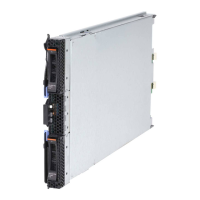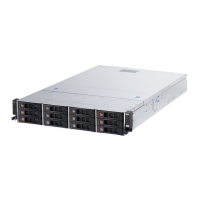Important: You must create the RAID array before you install the operating system
on the blade server.
You can use the LSI Logic Configuration Utility program to configure the storage
drives and the SAS controller. To start the LSI Logic Configuration Utility, see
“Using the LSI Logic Configuration Utility program.”
Using the LSI Logic Configuration Utility program
Use these instructions to start the LSI Logic Configuration Utility program.
You can use the LSI Logic Configuration Utility program to perform the following
tasks:
v Set the SAS device scan order
v Set the SAS ID for the controller
v Manage the SAS RAID configuration
To start the LSI Logic Configuration Utility program, complete the following steps:
Note: The LSI controller on your blade server is a UEFI compatible device and can
also be configured through the Setup utility for your blade server (see
“Configuring UEFI compatible devices” on page 62).
1. Turn on the blade server, and make sure that the blade server is the owner of
the keyboard, video, and mouse.
2. When the <<<Press Ctrl-C to start LSI Logic Configuration Utility>>>
prompt is displayed, press Ctrl+C.
3. Use the arrow keys to select the controller from the list of adapters; then, press
Enter.
4. Follow the instructions on the screen to change the settings of the selected
items; then, press Enter. If you select SAS Topology or Advanced Adapter
Properties, additional screens are displayed.
Using LAN over USB to interface the IMM
Unlike the BMC, the IMM does not require IPMI device drivers or USB daemons
for in-band IMM communication. Instead, a LAN over USB interface enables
in-band communications to the IMM; the IMM hardware on the system board
presents an internal Ethernet NIC from the IMM to the operating system. LAN
over USB is also called the "USB in-band interface" in the IMM Web interface.
Typically, the IMM IP address for the LAN over USB interface is set to a static
address of 169.254.95.118 with a subnet mask of 255.255.0.0. In the event of an IP
address collision on the network, the IMM might obtain a different IP address in
the 169.254.xxx.xxx range. The IMM first attempts to use the default static address,
169.254.95.118. If that IP address is already in use, the IMM attempts to randomly
obtain an address until it finds one that is not in use.
Because the IMM might obtain a random IP address for the LAN over USB
interface, the IBM Advanced Settings Utility (ASU) and firmware flash utilities,
DSA, and the IBM Director Agent use the Service Location Protocol (SLP) to
discover the IMM IP address. These tools perform an SLP multicast discovery on
the LAN over USB interface. When they receive a response from the IMM, they
obtain the attributes that contain the IP address the IMM is using for the LAN over
USB interface.
64 BladeCenter HS22 Type 7870 and 1936: Installation and User's Guide

